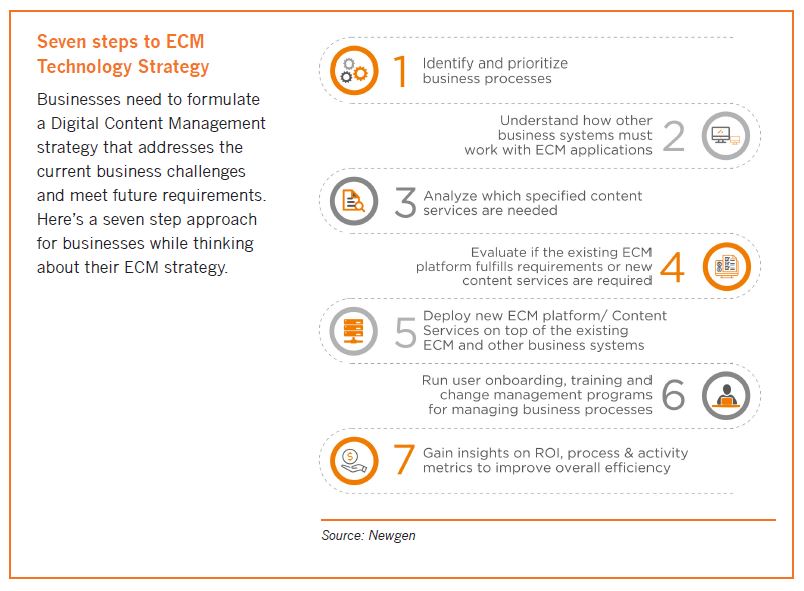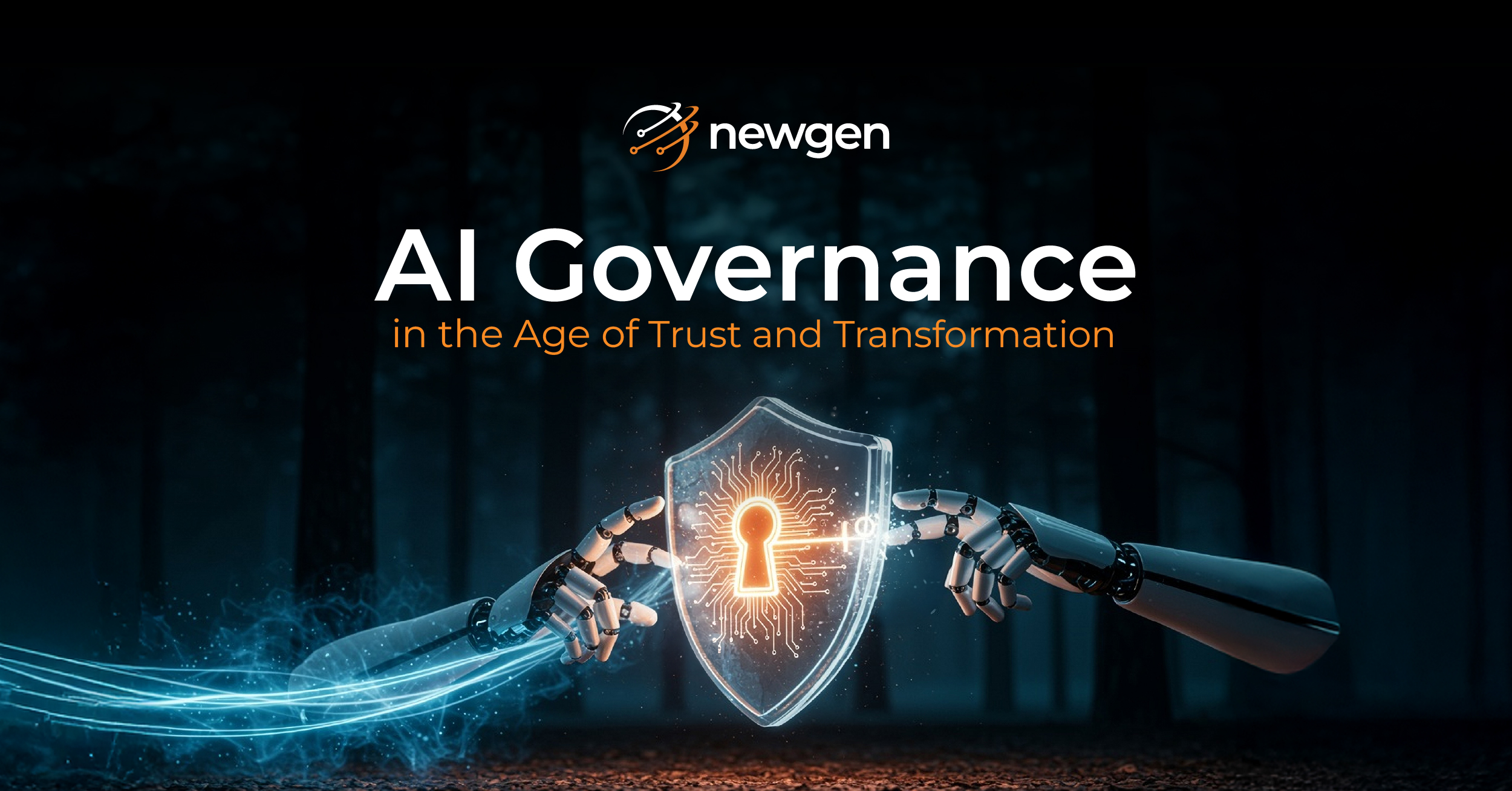Customer centricity is the driving force for businesses today. This creates an incessant pressure on businesses to understand customer requirements, track business risks and accordingly create a content strategy. The key to digital content strategy is to be able to drive context through business content and processes. By selecting the right enterprise content management platform, organizations can build customer-centric business apps and tie in the content to build context throughout the customer transaction.
Core Capabilities of Enterprise Content Management (ECM) to look out for
In order to meet the needs of digital customers, empower business users, and facilitate a ‘Boundary-less’ organization, it is important for enterprises to minutely consider each and every ECM software capability. Here’s a quick run-down of the 15 criteria against which organizations should evaluate the Enterprise Content Management (ECM) solution technology for rich content services.

To meet the needs of Digital Customers
1. Multi-channel content management for digital customers
Customers have developed an intrinsic need for products and services that provide “instant” gratification. They communicate with organizations over their preferred engagement channels, share information in multiple formats and demand engagement in real-time across all transactions. Organizations must understand the evolving expectations of their customers, map their journey across sales lifecycle,
and tap their preferred engagement modes. It is important to consider an Enterprise Content Management (ECM) platform with rich content services for processing any content type over the given channel mix.
2. Analytics for contextual customer interaction
Real-time customer engagement drives If put out of context, even creative ideas, strategies, and content, can lose their essence. Employees want to have context for each of the past customer interactions while interacting with customers. This enables them to respond in a timely, relevant and contextually accurate manner. It is essential to look at content services platform that provides efficient content & data analytics services at the core and allows users to consume the business-critical information for delivering the right response.
3. Automated operational workflows for real- time customer services
With the availability of myriad choices, ease and flexibility, today’s digital customers are more empowered than ever To surpass customer expectations, businesses should facilitate workers with automated operations so that they respond faster with ease. Enterprise content management (ECM) software should have automated workflow services for functional heads to map operational steps so that corresponding front- end and back-end users could work seamlessly and serve customers better and faster.
To Empower Business Users
4. 100% accurate content capture for faster turnaround time
Successful accomplishment in the first mile remarkably improves an organization’s customer experience and brings down operating costs, turnaround time, thereby fostering sustainability and profitability. It leaves a great impression on customers, paving the way for organizations to make their customers stick with their brand for long. Hence, organizations should look for full-featured advanced content capture services.
5. Quick capture, easy storage & accessibility of voluminous content
Front office focuses on capturing, storing and accessing information in real-time. On the other hand, back-end workers replicate the same for high-volume operations documents in one go. Robust capture services along with foundational content services over a well-connected content repository are core to diversified operations. And, must be taken into consideration while evaluating the platform.
6. Enterprise-wide content application access
Managing collaborative work demands higher Employees want boundary-less access to information so that it gets easy for them to share & access each other’s content, on any device. ECM Mobile applications facilitate field agents and office workers to capture and manage content across boundaries and geographies. Thus, while evaluating an Enterprise Content Management platform, organizations should consider enterprise- wide access to content with encrypted communication and multi-level authentication.
7. Robotic Process Automation for lightspeed tasks execution
Robotic Process Automation being a business catalyst enables organizations to redefine their operating models and withdraw their workforce from performing monotonous With the deployment of bots, on-demand analytics and real-time Business Activity Monitoring (BAM), human actions are effectively mimicked, thereby leading to digitized manual work, better throughput and efficient business operations. Bots do more tasks in less time, handle swivel chair tasks such as data entry, ensure round-the-clock operations and enable workers to be customer-centric over getting involved in trivial tasks.
8. Rules, regulations and policies
A Regulatory Compliance Officer has to ensure that operations comply with the set internal and external regulatory programs, standards and policies. Thus, it becomes necessary for organizations to be 100% compliant and consider microservices around records management, archival, process workflows, business rules, and complex events handling.
9. Deploy, Upgrade & Recover Fast.
Enterprise content management is deployed much faster with loosely coupled services over monolithic applications. The 18-months deployment cycles are now a thing of past. This offers assorted choices for customers to fail through fast in their application lifecycle, which reduces overall business risk.
Upgrade: With segregated content services, development teams get the flexibility to update only the relevant pieces of an application. This results in faster iteration and reduced downtime during upgrades.
Recover: ECM built on microservices architecture has no single point of failure as several functionalities are dispersed across different services. Thus, instead of taking the pain of repairing the whole platform, the required service can be repaired with ease.
To facilitate a ‘Boundary-less’ Organization
10. Repository agnostic ECM to connect disparate DMS
Several content repositories are used by multiple functional teams across departments. Thus, via distributed but connected repositories, users are bound to focus on “What” over “Where” and access required It thus underlines the emphasis for content strategists to look for virtual repository services and make sure that Enterprise Content Management platform (ECM) solution is repository agnostic.
11. Extensibility with content services integration/aggregation
As ECM system is intended to be used across business functions along with line of business systems, including CRMs, ERPs, BPM applications, integration complexity poses a key barrier to seamless business Hence, it is important to look for a hybrid integration approach that supports external microservice integration and/or external service aggregation.
12. User-centric modularity across ECM application landscape
Busy information workers develop applications around their business requirements via design-driven, low-code application development Graphical User Interface (GUI). The content management features can be effectively reused while developing others business Hence, to build apps faster, it is important to consider user-centric modularity.
13. ECM application environment & portability
Microservices architecture based ECM gives businesses the flexibility to deploy selected services in different environments – Public, Private and To produce optimal business results, ECM platform must allow users to deploy different components over required environments.
14. Pricing flexibility with predictable ROI
Functional department’s spending on ECM technology applications is strictly based on the return (in form of any desired metric say monetary savings, employee efficiency, number of transactions, customer handling time, more revenue and so on) vis-a-vis investment made. Business Heads are willing to invest in ECM technology to achieve the desired ROI with predictability.
15. Monitor business processes for continuous
Any business stakeholder (whether it’s a CEO, Functional Business Head, IT Head, CIO, Team Manager, Admin, End User) needs to track business processes for timely actions. Thus, while evaluating any ECM, it is important to ensure that there are reporting and analytics services to help generate required information for specific user sets.
You might be interested in





